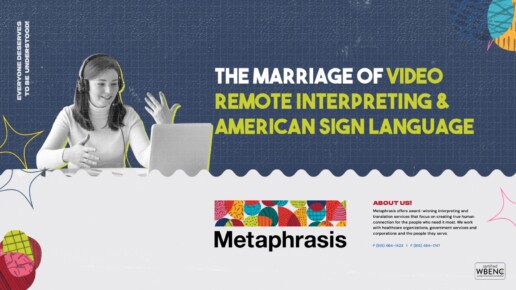The Marriage of Video Remote Interpreting and American Sign Language
Communication is the foundation of human interaction, yet millions of individuals who are deaf or hard of hearing face daily challenges due to language barriers. American Sign Language (ASL) is the primary means of communication for many within this community, and the demand for effective interpreting solutions has never been greater. Enter Video Remote Interpreting (VRI)—a technology-driven approach that bridges the communication gap with real-time access to certified interpreters.
Metaphrasis, a leader in language solutions, has been at the forefront of integrating ASL with VRI, revolutionizing the way businesses, healthcare providers, and institutions serve the deaf and hard-of-hearing community. This blog explores the synergy between ASL and VRI, highlighting how this marriage enhances accessibility, efficiency, and inclusivity.
Understanding Video Remote Interpreting (VRI)
VRI is a modern interpretation service that utilizes video conferencing technology to connect an interpreter with individuals who need real-time language assistance. Unlike on-site interpreting, which requires the physical presence of an interpreter, VRI allows users to access professional interpreters remotely via a smartphone, tablet, or computer.
How VRI Works
- The deaf or hard-of-hearing individual and the hearing person communicate through a screen.
- A qualified ASL interpreter appears on the video call and facilitates communication between both parties.
- The interpreter translates spoken language into ASL and vice versa, ensuring smooth interaction.
This instant accessibility makes VRI a game-changer in various sectors, including healthcare, education, legal settings, and customer service.
The Role of ASL in Video Remote Interpreting
American Sign Language is more than just a translation of English into gestures; it is a rich, complex language with its own grammar and syntax. ASL interpreters must be proficient in cultural nuances, facial expressions, and hand movements to ensure clear and effective communication.
VRI services must incorporate highly skilled ASL interpreters who can maintain the integrity of the conversation. This ensures that deaf and hard-of-hearing individuals receive accurate interpretations without miscommunication.
Benefits of ASL and VRI Integration
Increased Accessibility
One of the most significant benefits of VRI is its ability to provide immediate ASL interpreting services anywhere, anytime. Many rural areas lack in-person interpreters, making VRI a crucial tool for accessibility. With just a device and an internet connection, businesses and institutions can provide equitable communication access.
Cost-Effectiveness
Traditional on-site ASL interpreting can be expensive due to travel costs and hourly minimums. VRI eliminates these additional expenses, making language services more affordable for organizations while ensuring that deaf individuals receive the assistance they need.
Faster Response Time
Emergencies often require instant communication solutions. Whether in a hospital, police station, or court, waiting for an in-person interpreter can delay critical interactions. VRI allows ASL interpreters to be available within seconds, ensuring urgent matters are handled efficiently.
Enhancing Communication in Various Sectors
- Healthcare: Patients can communicate directly with medical professionals without delays, ensuring accurate diagnosis and treatment.
- Education: Schools and universities can provide equal learning opportunities to deaf students by offering VRI services for lectures and meetings.
- Legal Settings: VRI ensures fair representation and understanding in legal proceedings for deaf individuals.
- Customer Service: Businesses can cater to deaf customers efficiently, improving overall customer satisfaction.
Challenges and Solutions in VRI for ASL
Despite its advantages, VRI does have some challenges, including technical issues, interpreter availability, and user training.
Internet Connectivity and Technical Issues
A stable internet connection is crucial for smooth video communication. Organizations must invest in high-speed internet and quality video conferencing software to avoid disruptions.
Interpreter Availability
While VRI offers quick access to interpreters, peak hours or increased demand can lead to delays. Companies like Metaphrasis ensure adequate staffing to meet real-time needs.
Training and Adoption
Some individuals may be unfamiliar with VRI technology. Providing proper training to employees, patients, and customers can improve adoption rates and overall effectiveness.
The Future of VRI and ASL
The integration of artificial intelligence and machine learning may further enhance VRI services in the future. Innovations such as AI-driven sign language recognition and real-time transcription tools can complement human interpreters, making communication even more seamless.
As technology evolves, the relationship between ASL and VRI will continue to strengthen, paving the way for a more inclusive society. Companies like Metaphrasis are setting new standards in language accessibility, ensuring that deaf and hard-of-hearing individuals receive the communication support they deserve.
Conclusion
The marriage of Video Remote Interpreting and American Sign Language represents a powerful step toward inclusivity and accessibility. VRI has revolutionized the way ASL interpretation is delivered, offering instant, cost-effective, and efficient communication solutions. As more businesses and institutions embrace this technology, the barriers faced by the deaf and hard-of-hearing community will continue to diminish.
By leveraging the expertise of language service providers like Metaphrasis, we can create a world where communication is truly universal, ensuring that everyone, regardless of their hearing ability, has an equal voice.

